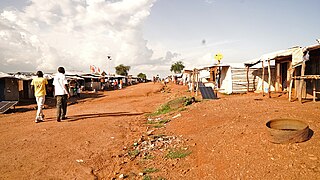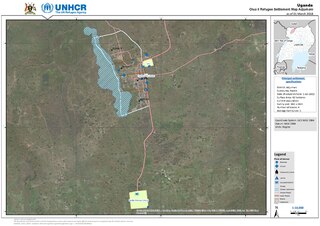Ayilo 2 Refugee settlement | |
|---|---|
| Coordinates: 3°15′32″N31°57′11″E / 3.25889°N 31.95306°E | |
| Country | |
| Region | Northern Region |
| District | Adjumani |
Ayilo 2 refugee settlement is one of the refugee camps in Adjumani District in the Northern Region of Uganda.
Ayilo 2 Refugee settlement | |
|---|---|
| Coordinates: 3°15′32″N31°57′11″E / 3.25889°N 31.95306°E | |
| Country | |
| Region | Northern Region |
| District | Adjumani |
Ayilo 2 refugee settlement is one of the refugee camps in Adjumani District in the Northern Region of Uganda.
Ayilo 2 refugee settlement is one of the camps in Adjumani District of Northern Region of Uganda that was established on 6 July 2014 to host the influx of South Sudanese refugees due to the South Sudan Civil War of 2013 and as well as those who fled the Country in the 1990s, who were not able to return home and chose to stay in Uganda. [1]
Ayilo 2 refugee settlement together with Ayilo 1 refugee camp have a combined surface area of 776 hectares and both camps have a combined population of 39,000 refugees of the South Sudanese origin.
According to The Observer news findings and research, the refugees at Ayilo 2 refugee camp have resorted to selling their food ration distributed as a way to buy soap, salt and clothing for the children to use and make the family prepare the food they are given with minimal lack. This is because the distributed food does not come with those requirements that are intermediate and they end up doing the needful of selling food to get their needs. [2]

According to the Arizona State University, the existing healthcare centre at Ayilo 2 refugee camp has a capacity to host the incoming number of patients that seek for the health care issues to be addressed. The centre has block structures that handles refugees as well as Nationals, the Host Communities for the provision of all its services. This has proved effective for the settlers as their health has been put to the consideration. [3]
Ayilo 2 Refugee Settlement Piped Water Supply System through the Ministry of Water and Environment of Uganda in Adjumani District is underway to provide water services to the refugees who are in dire need for these services as a way to promote the health and sanitation at the camp since the sanitation and water services were at a high risk of posing diseases and infections. [4] [5]
By January 2011 the United Nations High Commissioner for Refugees (UNHCR) estimated that there are 262,900 Sudanese refugees in Chad. The majority of them left Sudan escaping from the violence of the ongoing Darfur crisis, which began in 2003. UNHCR has given the Sudanese refugees shelter in 12 different camps situated along the Chad–Sudan border. The most pressing issues UNHCR has to deal with in the refugee camps in Chad are related to insecurity in the camps,, malnutrition, access to water, HIV and AIDS, and education.
Africa Humanitarian Action (AHA) is a non-governmental organization that provides relief services to countries in Africa. It was founded by Dr. David Zawde in 1994 in response to the Rwandan genocide.
South Sudanese refugees are persons originating from the African country of South Sudan, but seeking refuge outside the borders of their native country. The world's youngest independent country has a recent and troubled history of prolonged conflicts and ecosystem mismanagement such as overlogging, which has led to desertification. These forces have resulted not only in violence and famine, but also the forced migration of large numbers of the population, both inside and outside the country's borders. South Sudan was cited as the largest refugee crisis in 2016, being the world's third largest, followed by Syria and Afghanistan. As of 2022, the UNHCR estimated that there were 2.4 million refugees under its mandate originating from South Sudan, making the country the fifth largest source of refugees.

Rhino Camp Refugee Settlement is a refugee camp located in the districts of Madi-Okollo and Terego District in North Western Uganda.
Pagirinya Refugee Settlement is a refugee camp in Eastern Adjumani District in Northern Uganda.

Bidibidi Refugee Settlement is a refugee camp in the Yumbe District of northwestern Uganda. Home to over 270,000 South Sudanese refugees fleeing the ongoing civil war in early 2017, it was among the largest refugee settlements in the world at the time, and may have been the largest. As of 2018, that distinction was claimed by Kutupalong refugee camp for displaced Rohingya in Bangladesh.
Imvepi Refugee Settlement is a refugee camp in Terego District in West Nile Sub Region of northwestern Uganda.
Nyumanzi Refugee Settlement is a refugee camp in Adjumani District in northwestern Uganda. Established in 2014, it hosts about 52,000 South Sudanese refugees.

Alere 2 Refugee Settlement is located in Adjumani District in the Northern Region of Uganda.
Baratuku refugee settlement is a refugee settlement in Adjumani district Uganda
Mungula II Refugee Settlement is a refugee camp found in Adjumani District Itirikwa subcounty in Northern Uganda.
Olua I Refugee settlement is a refugee camp in eastern Adjumani District in Northern Uganda. The Refugee settlement has its primary country as Uganda and other country south Sudan.
Mungula refugee settlement is located in Adjumani district in northern Uganda on the border with South Sudan.
Mirieyi refugee settlement is a refugee camp in Ofua Sub County in the Adjumani District of Uganda.
Oliji refugee settlement is a refugee camp in Adjumani District of Uganda.

Boroli refugee settlement is a refugee camp located in the Pakele Sub County of Adjumani District Northern Region, of Uganda.
The Agojo refugee settlement is a refugee camp in the Adjumani District of Northern Uganda, opened in 2016 in response to an influx of South Sudanese refugees fleeing the insecurity in their country. It is located 16 kilometres (10 mi) west of the town of Adjumani.

The Maaji refugee settlements are three refugee camps located in Adjumani District in the Northern Region of Uganda, established in 1997. In June 2018, there were 41,764 registered refugees, accounting for 10% of the district's total population. It has primarily admitted refugees from the Second Sudanese Civil War and the ongoing South Sudanese Civil War. The settlements have been attacked several times by the Lord's Resistance Army, along with other camps in the region such as the Baratuku refugee settlement.
Ayilo 1 refugee settlement is a prominent refugee camp located in Adjumani District, situated in the Northern Region of Uganda.

Olua II Refugee Settlement is a refugee camp located in the eastern part of Adjumani District in Northern Uganda. It was established in 2012 to host South Sudanese refugees fleeing inter-communal violence. The settlement has a population of over 18,000 registered refugees.